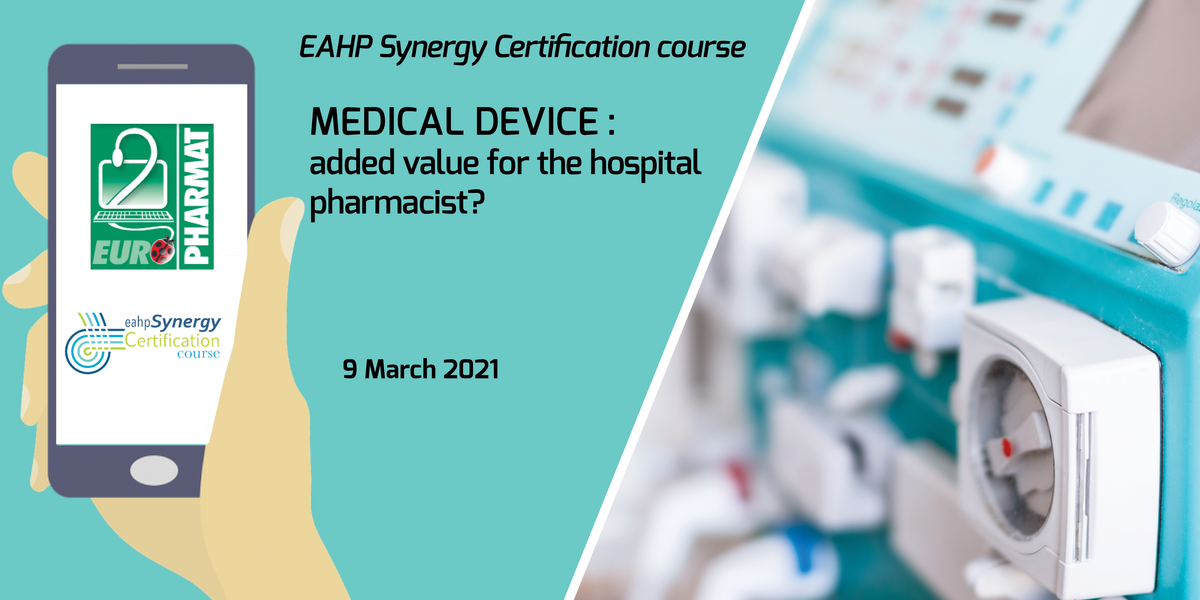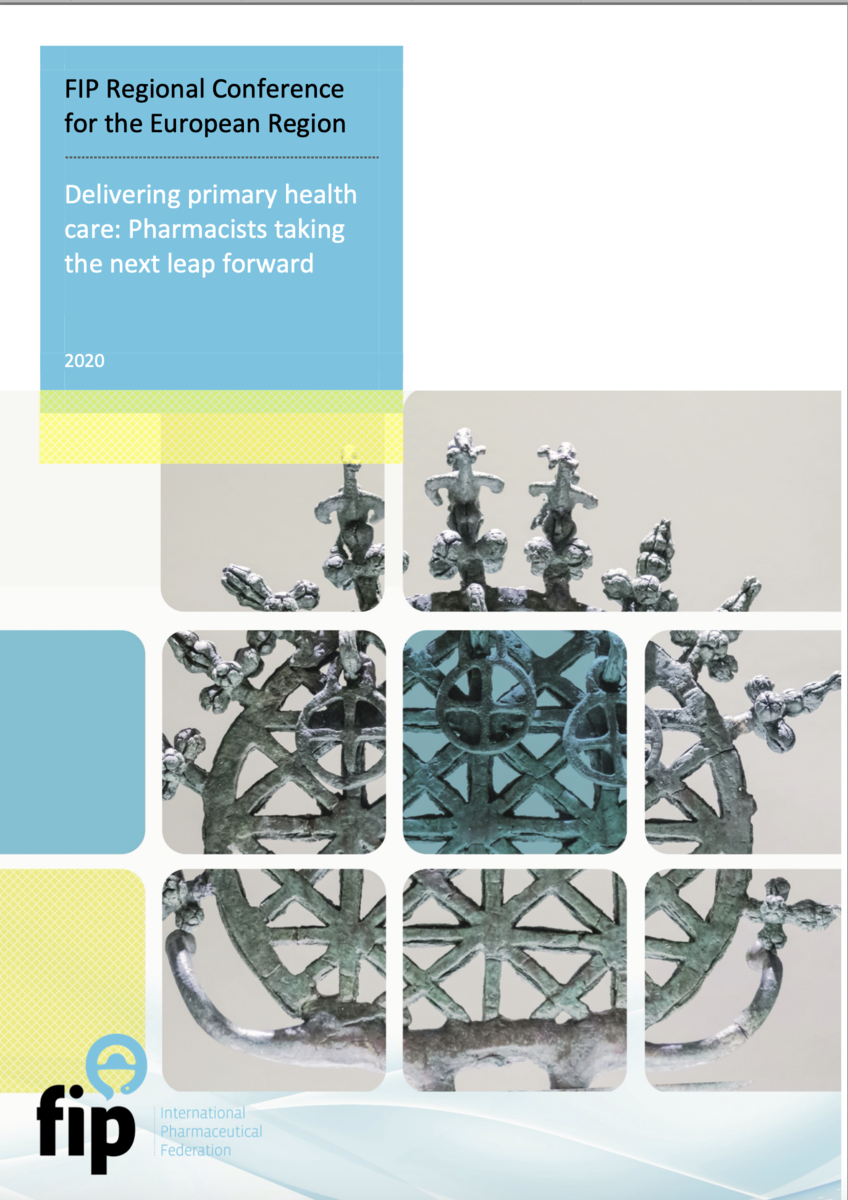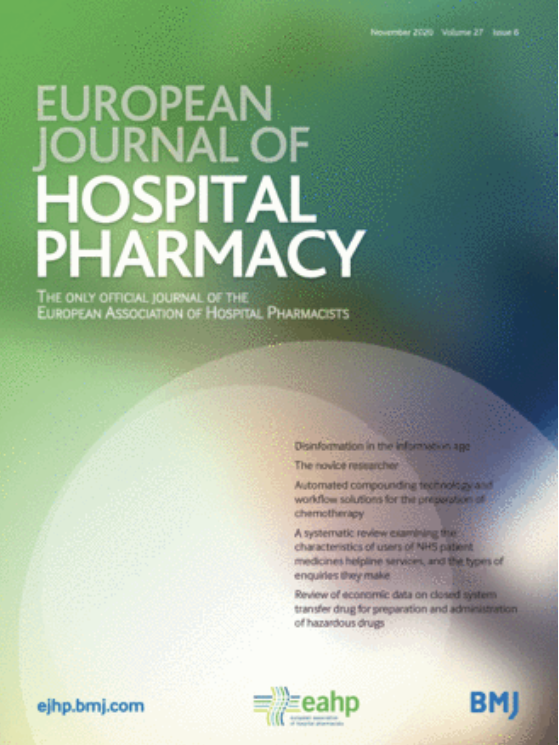EU MONITOR Sign up for the Synergy Certification Course on medical devices!
The EAHP EU Monitor is a regular round up of news relevant to hospital pharmacy in Europe.
New Synergy Certification Course with Euro-Pharmat

The European Association of Hospital Pharmacists (EAHP) is launching its next Synergy Certification Course focusing on medical devices. The event will take place in Toulouse, France on 9th March 2021. It is organised by our colleagues from Euro-Pharmat.
The topic of this brand new course is “Medical device therapeutic product: What added value from the pharmacist at the hospital?”. During the event information on the regulation for medical devices in the European Union will be shared by speakers from France. The medical devices sector is essential for the provision of healthcare to citizens and is an important player in both the European and global economy. The afternoon session is dedicated to the pharmacists’ role in the management of the patient by medical devices. Interested hospital pharmacists are encouraged to sign up for this exciting event!
See the programme HERE
Register HERE
Find the accommodation form HERE
EAHP launches new working space for members and partners with Wolters Kluwer
Getting access to EAHP’s member materials has never been easier. Thanks to the new working space for members, EAHP’s member associations and their members can now find all information in one spot.
EAHP would also like to use this occasion to inform that we have partnered with Wolters Kluwer to offer EAHP members a subscription to Lexicomp® at a special member rate. For over 20 years Lexicomp® has provided smart, independent drug information resources that help students excel in classes and support the decision-making in rotations. Lexicomp® equips EAHP’s members with resources to assist them in their professional careers.
Furthermore, Wolters Kluwer as a provider of UpToDate® also offers to EAHP members valuable offers and discounts. With UpToDate®, hospital pharmacists that are members of EAHP can have access to more than 11,800 Clinical Topics in 25 specialities, more than 9,300 Graded Recommendations and 4,200 Pharmacotherapy Tables and Algorithm.
Check out the new working space for EAHP members HERE
What do you think about the EU Monitor?

Every two weeks you are receiving EAHP’s newsletter. We want to hear from you. Please help us to improve the EU Monitor by answering a short survey! It will not take you more than 3 minutes.
Access the survey HERE
FIP publishes the report of the Regional Conference for the European Region

In fall 2019, EAHP’s Vice President Aida Batista attended the Regional Conference for the European Region of the International Pharmaceutical Federation (FIP) to share the Association’s views on medicines shortages and to discuss the importance of seamless care for patients. The event was held in Ankara, Turkey and brought together pharmacists from many different countries.
The aim of the “FIP Regional Conference for the European Region Report” was to act as a regional roadmap for action to transform primary health care. The report describes the outcomes of the conference, including the results of a survey among all pharmacy leaders in the European Region to follow up on national priorities and strategies to implement the Ankara Commitment to Action. The report also provides a focus chapter on the mapping of the FIP Development Goals against the Ankara Commitment to Action to outline pharmaceutical practice, service, education and workforce development needs in the context of primary health care.
Read the conference report HERE
Updates from the European Medicines Agency
The European Medicines Agency (EMA) published new communications on the first long-acting injectable antiretroviral therapy for HIV which was recommended for approval, a new gene therapy to treat the rare genetic disorder metachromatic leukodystrophy and the first treatment for the rare condition primary hyperoxaluria type 1.
First long-acting injectable antiretroviral therapy for HIV recommended for approval
EMA has recommended the granting of marketing authorisations for two new antiretroviral (ARV) medicines, Rekambys (rilpivirine) and Vocabria injection (cabotegravir), to be used together for the treatment of patients with human immunodeficiency virus type 1 (HIV-1) infection. The two medicines are the first ARVs that come in a long-acting injectable formulation. This means that instead of daily pills, patients receive intramuscular injections monthly or every two months.
The combination of Rekambys and Vocabria injection is intended for maintenance treatment of adults who have undetectable HIV levels in the blood (viral load less than 50 copies/ml) with their current ARV treatment, and when the virus has not developed resistance to certain class of anti-HIV medicines called non-nucleoside reverse transcriptase inhibitors (NNRTIs) and integrase strand transfer inhibitors (INIs).
The opinion by EMA’s human medicines committee (CHMP) is based on data from three phase 3 randomised, open-label, multicentre clinical trials with HIV-infected, treatment naïve (i.e. never taken ARV therapies) or successfully treated men and women aged 18 years or older. These studies demonstrated the safety and efficacy of Rekambys and Vocabria regimen when administered every four or eight weeks. Because the levels of the active substances fall slowly, it is even more important than with standard ARV medicines that patients adhere to the dosing schedule of Rekambys and Vocabria to avoid the risk of the virus developing resistance.
As for all medicines, a risk management plan (RMP) will ensure rigorous safety monitoring of the medicines once authorised across the EU. Further efficacy and safety data will be collected through a prospective cohort study and a real-world five-year drug utilisation study. The results will be included in post-marketing safety reports. The most common side effects observed in clinical trials with the injectable regimen Rekambys and Vocabria include injection site reactions followed by headache, pyrexia, nausea, fatigue, asthenia, myalgia and dizziness.
The opinion adopted by the CHMP at its October 2020 meeting is an intermediary step on Rekambys and Vocabria’s path to patient access. The CHMP opinion will now be sent to the European Commission for the adoption of a decision on an EU-wide marketing authorisation. Once a marketing authorisation has been granted, decisions about price and reimbursement will take place at the level of each Member State, taking into account the potential role/use of this medicine in the context of the national health system of that country.
More information is available HERE
New gene therapy to treat rare genetic disorder metachromatic leukodystrophy
EMA has recommended granting a marketing authorisation in the European Union for the gene therapy Libmeldy to treat metachromatic leukodystrophy (MLD), a rare inherited metabolic disease that affects the nervous system. Libmeldy is indicated for use in children with the ‘late infantile’ or ‘early juvenile’ forms of MLD, who have been identified as carriers of the defective gene but have not yet developed symptoms. It is also indicated in children who have been diagnosed with the early juvenile form who have started developing symptoms but still have the ability to walk independently and before the onset of cognitive decline.
There is currently no cure for MLD, a disease caused by a fault in the gene that produces an enzyme called arylsulfatase A (ARSA). This leads to a build-up of substances called sulfatides in the central and peripheral nervous system. The damage caused by this leads to the progressive loss of motor function and cognitive ability and, ultimately, death.
In its overall assessment of the available data, the Committee for Advanced Therapies (CAT), EMA's expert committee for cell- and gene-based medicines, found that the benefits of Libmeldy outweighed the possible risks in patients with the late infantile or early juvenile forms of MLD who have not yet any symptoms and in patients with early juvenile form with early symptoms of the disease. In clinical studies, Libmeldy showed that it was most effective in patients who had not yet developed symptoms. Once they had received the medicine, their performance with regard to cognitive and motor function was maintained and comparable to that of their healthy peers during the observation period.
However, in patients with the early juvenile form of MLD, who already showed symptoms when they were first given Libmeldy, the effects were less pronounced. A possible slower decline in motor function was seen while cognitive function was maintained compared to what is known about the disease progression in untreated patients. The further the disease had already progressed in these patients, the fewer positive effects could be seen. Therefore, in patients with early juvenile form of MLD who have already developed symptoms, the CAT concluded that treatment success is maximized if at the time of diagnosis, screening for treatment and treatment, children can still walk independently and have no signs of cognitive decline.
The main adverse reactions observed in trials were fever and a diminished ability to fight infections (febrile neutropenia), inflammation of the mouth and lips (stomatitis) and the gastro-intestinal tract (mucosal inflammation). These side effects are related to the conditioning medicine used to prepare the child for treatment with Libmeldy. As for all haematopoietic stem cell interventions, there is a theoretical risk that patients develop malignancies such as leukaemia or lymphoma later in life. The CHMP, EMA’s human medicines committee, agreed with the CAT’s conclusions and recommended approval of Libmeldy in these patients. As part of its recommendation for marketing authorisation, the committees requested that the company uses a registry of patients to learn more about the long-term efficacy and safety of the medicine. Results from this registry study will be submitted periodically for evaluation to EMA.
The company has also been requested to propose measures to safely reduce the overall time needed to supply the patient with the individualized product. This is because treatment is more effective before the onset of symptoms or in the presence of early mild symptoms, before symptoms become more severe and disease is rapidly progressive. Treatment with Libmeldy should only be carried out in qualified specialised treatment centres, and patients and their carers should receive extra educational material to warn them of the symptoms of leukaemia and lymphoma.
The opinion adopted by the CHMP is an intermediary step on Libmeldy’s path to patient access. The opinion will now be sent to the European Commission for the adoption of a decision on an EU-wide marketing authorisation. Once a marketing authorisation has been granted, decisions about price and reimbursement will take place at the level of each Member State, taking into account the potential role/use of this medicine in the context of the national health system of that country.
More information is available HERE
First treatment for rare condition primary hyperoxaluria type 1
EMA has recommended granting a marketing authorisation in the European Union for Oxlumo (lumasiran) for the treatment of primary hyperoxaluria type 1 (PH1). Primary hyperoxaluria is a rare inherited disorder characterised by the overproduction of oxalate. Oxalate can form calcium oxalate deposits, which can cause stones in the kidney and urinary tract (structures that carry urine) as well as injury to other organs such as the heart, eyes, bones and skin. Characteristic symptoms of the disease include renal colic, blood in the urine, frequent urinary tract infections and stomach pain. PH1 is the most common and the most severe form of the disease, accounting for 80% of all cases. The condition is very rare with an estimated prevalence of 0.05 in 10,000 people in the EU.
There are currently no approved medicines for PH1 in the EU. Different treatments are used to prevent the accumulation of calcium oxalate such as dietary changes, drinking plenty of fluids and taking vitamin B6. In certain cases kidney and/or liver transplantation is required. Untreated PH1 leads to kidney failure, which is life-threatening.
Oxlumo will be available as solution for injection (189 mg/ml). The active substance of Oxlumo is lumasiran, a small interfering ribonucleic acid that causes degradation of the messenger ribonucleic acid involved in the synthesis of the enzyme glycolate oxidase (GO) in the liver, leading to decreased GO enzyme levels in the body. This results in reduction of plasma and urinary oxalate levels, the underlying cause for the symptoms in patients with PH1.
The benefit of Oxlumo is its ability to reduce oxalate levels in the plasma and 24-hour urinary oxalate excretion, when compared to a placebo treatment. This was observed during a 6-month clinical trial involving 38 patients aged 6-60. In this study, treatment with Oxlumo resulted in normalisation of oxalate excretion in 52% of patients and near normalisation in 84% of patients. The most common side effects are injection site reactions and abdominal pain.
Oxlumo was accepted in EMA’s PRIME scheme and has benefited from the extra support offered by the Agency to medicines that have a particular potential to address patients' unmet medical needs. EMA’s human medicines committee (CHMP) reviewed the application for Oxlumo under its accelerated assessment procedure, which allows the speeding up of patients' access to medicines.
The opinion adopted by the CHMP is an intermediary step on Oxlumo’s path to patient access. The opinion will now be sent to the European Commission for the adoption of a decision on an EU-wide marketing authorisation. Once a marketing authorisation has been granted, decisions about price and reimbursement will take place at the level of each Member State, taking into account the potential role/use of this medicine in the context of the national health system of that country.
More information is available HERE
EJHP: Read the November issue!

The latest issue of the European Journal of Hospital Pharmacy (EJHP) is available. It features two editorials, systematic reviews on the characteristics of enquirers and enquiries to patient medicines helpline service and on the implementation of chemotherapy compounding automation and several original articles and short reports. Among other things, it informs about EAHP’s 50th General Assembly during which András Süle was designated as President-Elect.
Read the November issue HERE.
 [COVID-19 Updates]
[COVID-19 Updates]
EAHP’s COVID-19 Resource Centre
To assist its member associations and individual hospital pharmacists in this critical time with the provision of the best possible care for patients, EAHP has decided to gather and make available information on COVID-19 relevant for the hospital pharmacy profession.
Access the Resource Centre HERE
Journal of the Faculty of Medicine and Dentistry of the Université catholique de Louvain (UCL) - COVID-19 and diabetes
The article summarises current information available on the clinical presentation and risks associated with COVID-19 in diabetic patients. The authors propose several recommendations for the management of COVID-19-infected diabetes patients.
Access the article HERE
The Lancet Diabetes & Endocrinology - Practical recommendations for the management of diabetes in patients with COVID-19
The article provides insight into potential mechanistic links between the novel coronavirus infection and diabetes, presents practical management recommendations and elaborates on the differential needs of several patient groups.
Access the article HERE
Pharmaceutical Chamber of Serbia - Information and temporary guide for Pharmacists and the Pharmacy
The Pharmaceutical Chamber of Serbia has put together information and guidelines for pharmacists.
Access the article HERE
The European Statements of Hospital Pharmacy – Have you ever explored their dedicated website?

In 2014 EAHP adopted the European Statements of Hospital Pharmacy after an open Delphi consultation with national hospital pharmacy associations, European patient groups, doctors and nursing groups. On the Statement website, you can find information about the European Statements, their development, adoption and implementation. Have a look in case you never visited the Statement website.
___________________________________________________________________________________
Consultations
![]()
EMA – Guideline on registry-based studies
The guideline was developed based on the comments received on the discussion paper on ‘Methodological and operational considerations on the use of patient disease registries for regulatory purposes’, that went through a public consultation between November 2018 and June 2019, and a consultation of EMA Committees and Working parties.
Deadline – 31st December 2020
Access the consultation HERE
EDQM – Pharmeuropa PaedForm, Issue 2
The EDQM has just released issue 2 of Pharmeuropa PaedForm, in which the third monograph elaborated by the PaedForm Working Party, the draft text for an ethanol-free formulation for Furosemide 2 mg/mL Oral Solution, is published for public consultation prior to its inclusion in the European Paediatric Formulary.
Deadline – 31st December 2020
Find more information HERE






